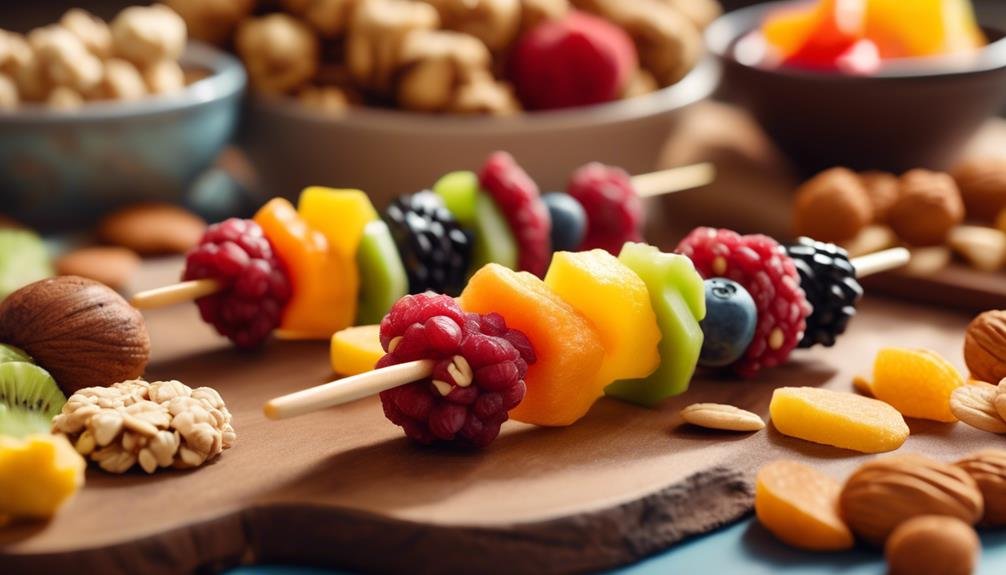"Cherishing Little Steps - A Haven for Baby and Family Journeys"
Nut-Free Diets for Kids
Are you a parent struggling to navigate the world of nut-free diets for your kids? Well, worry not! Nut allergies have become increasingly prevalent, making it crucial for parents to be well-informed about the importance of eliminating nuts from their children's diets.
But it doesn't end there! Hidden sources of nuts can be deceptive, making it even more challenging to ensure your child's safety.
So, let's explore the strategies for nut-free meal planning, as well as some tasty and nut-free snack and recipe ideas that your little ones are sure to love.
Stay tuned for some valuable insights that will help you keep your kids safe and healthy.
Key Takeaways
- Nut allergies occur when the immune system mistakenly identifies proteins in nuts as harmful.
- Following a nut-free diet is crucial for individuals with nut allergies to prevent allergic reactions.
- Nuts can be hidden in unexpected places, so it's important to read food labels carefully.
- Strategies for nut-free meal planning include reviewing recipes, using allergy-friendly substitutes, labeling containers, and communicating with schools and other places where meals are served.
Understanding Nut Allergies

Understanding nut allergies is crucial for parents and caregivers to ensure the safety and well-being of children who are affected. Common nut allergies include peanuts, almonds, cashews, walnuts, and hazelnuts. These allergies occur when the immune system mistakenly identifies proteins in nuts as harmful and triggers an allergic reaction.
Symptoms of nut allergies can vary from mild to severe. Mild symptoms may include itching, hives, or swelling around the mouth. In more severe cases, individuals may experience difficulty breathing, wheezing, or a drop in blood pressure. Anaphylaxis, a life-threatening allergic reaction, can occur and requires immediate medical attention.
Reactions to nut allergies can be triggered by ingesting nuts or by coming into contact with nut particles. Even small traces of nuts in food or on surfaces can cause a reaction in sensitive individuals. It's important to carefully read food labels and be aware of cross-contamination risks when preparing or serving meals.
If your child has a nut allergy, it's crucial to inform their school, daycare, and other caregivers to ensure they avoid exposure. Additionally, carrying an epinephrine auto-injector, such as an EpiPen, is recommended in case of an emergency.
Importance of Nut-Free Diets
Following a nut-free diet is crucial for individuals with nut allergies to prevent allergic reactions and ensure their safety. By eliminating nuts and their byproducts from their diet, they can avoid the risk of experiencing severe symptoms such as hives, difficulty breathing, and even anaphylaxis.
A nut-free diet offers several benefits that go beyond allergy management. It encourages individuals to explore alternative sources of nutrients, promoting a well-rounded and diverse diet. By incorporating a variety of fruits, vegetables, whole grains, and lean proteins, they can still obtain essential vitamins, minerals, and antioxidants necessary for optimal health.
To help you understand the importance of a nut-free diet, here's a table that highlights common alternatives to nuts:
| Nut Products | Nut-Free Alternatives |
|---|---|
| Peanut butter | Sunflower seed butter |
| Almond milk | Oat milk |
| Cashew cheese | Nut-free cheese alternatives |
| Walnut oil | Olive oil |
These alternatives offer similar tastes and textures, making it easier for individuals to transition to a nut-free diet without feeling deprived. It's essential to read food labels carefully as nuts can often be hidden in unexpected places, such as sauces and baked goods.
Hidden Sources of Nuts

Be aware of the hidden sources of nuts in your diet to ensure the safety of individuals with nut allergies. While nuts are commonly found in obvious food products like granola bars and trail mix, there are hidden dangers that can catch you off guard. Reading food labels is crucial in identifying potential sources of nuts that may not be immediately obvious.
When reading food labels, look out for terms like 'may contain nuts' or 'processed in a facility that also processes nuts.' These warnings indicate that there's a possibility of cross-contamination, which can be dangerous for those with severe nut allergies. Additionally, some ingredients may have different names that could indicate the presence of nuts. For example, arachis oil is another term for peanut oil, while mandelonas are almond-flavored peanuts.
It's not just food products that can harbor hidden sources of nuts. Non-food items like lotions, shampoos, and even pet food can contain nut oils or extracts. It's essential to carefully read the ingredient lists of these products and be aware of any potential allergens.
Strategies for Nut-Free Meal Planning
To ensure the safety of individuals with nut allergies, it's important to have effective strategies in place for nut-free meal planning. Meal prepping can be a great way to ensure that you have safe and allergy-friendly meals ready to go.
Start by reviewing recipes and identifying any potential sources of nuts. Look for allergy-friendly substitutes that can be used instead. For example, you can use sunflower seed butter or soy nut butter as a replacement for peanut butter. Additionally, consider using alternative flours like oat flour or coconut flour instead of almond flour.
When meal prepping, make sure to label all containers clearly to avoid any cross-contamination. It's also a good idea to have a designated area in your kitchen for nut-free meal preparation. This will help minimize the risk of accidental exposure.
Finally, communicate with schools, daycares, or any other places where your child may eat meals outside of the home. Make sure they understand the seriousness of the allergy and the importance of providing nut-free meals.
With these strategies in place, you can ensure that your child's meals are safe and nut-free.
Nut-Free Snack and Recipe Ideas

Explore a variety of delicious and nut-free snack and recipe ideas to keep your child safe and satisfied. When it comes to nut-free alternatives, there are plenty of options available. Replace peanut butter with sunflower seed butter or soy nut butter for sandwiches or as a dip for fruits and vegetables. Swap out almond flour with alternatives like coconut flour or oat flour for baking. Here are some nut-free snack and recipe ideas to try:
| Snacks | Recipes | Baked Goods |
|---|---|---|
| Rice cakes with hummus | Veggie sushi rolls | Banana bread |
| Apple slices with dip | Quinoa salad | Blueberry muffins |
| Carrot sticks with dip | Chickpea salad | Oatmeal cookies |
| Popcorn | Lentil soup | Pumpkin bread |
When it comes to nut-free baking, there are a few tips to keep in mind. First, always read labels carefully to ensure that the ingredients you use are nut-free. Look for products that are specifically labeled as nut-free or made in a nut-free facility. Additionally, be aware of cross-contamination when using shared kitchen tools or surfaces. Clean them thoroughly before preparing nut-free recipes. Finally, consider using alternatives like seeds, such as sunflower or pumpkin seeds, as a crunchy topping for muffins or breads. With these nut-free snack and recipe ideas, you can provide your child with safe and delicious options that they will enjoy.
Frequently Asked Questions
How Do I Know if My Child Has a Nut Allergy?
You can identify if your child has a nut allergy by looking for signs such as hives, difficulty breathing, or stomach pain after eating nuts. To prevent nut allergies, avoid exposing your child to nuts early on.
Can My Child Outgrow a Nut Allergy?
You might be wondering if your child can outgrow a nut allergy. Well, the good news is that some kids do, but it's not guaranteed. Allergic reactions can be serious, so it's important to stay cautious and talk to your doctor.
Are There Any Alternative Sources of Protein for Kids With Nut Allergies?
Looking for alternative protein sources for your child with a nut allergy? There are plenty of options to choose from, such as beans, lentils, dairy products, and seeds. Nut-free snacks like yogurt and cheese can also provide protein.
Can Children With Nut Allergies Eat Foods That Are Processed in the Same Facility as Nuts?
Can kids with nut allergies eat foods processed in the same facility as nuts? It's best to avoid these foods to prevent cross-contamination and potential allergic reactions. Here are some tips for managing nut allergies at school.
What Should I Do if My Child Accidentally Consumes Nuts?
If your child accidentally consumes nuts, stay calm and seek medical help immediately. Look out for symptoms of nut allergies like hives, difficulty breathing, or swelling. Prompt action is crucial for managing accidental nut consumption.
Conclusion
In conclusion, nut-free diets for kids are crucial for their safety and well-being. Understanding nut allergies and the hidden sources of nuts is essential for effective meal planning.
By implementing strategies and finding creative nut-free snack and recipe ideas, parents can ensure their children's dietary needs are met without compromising their health.
So, let's prioritize nut-free diets to nurture our kids' health and happiness!


